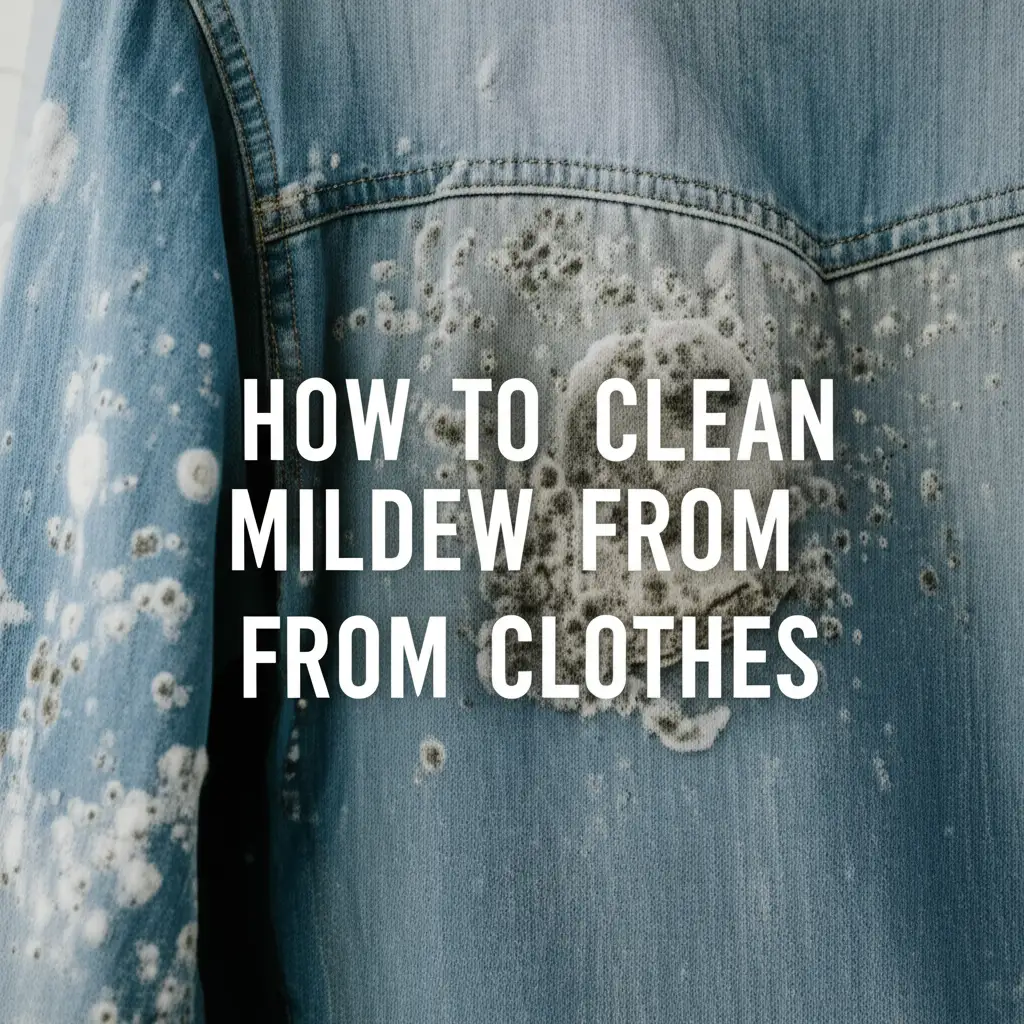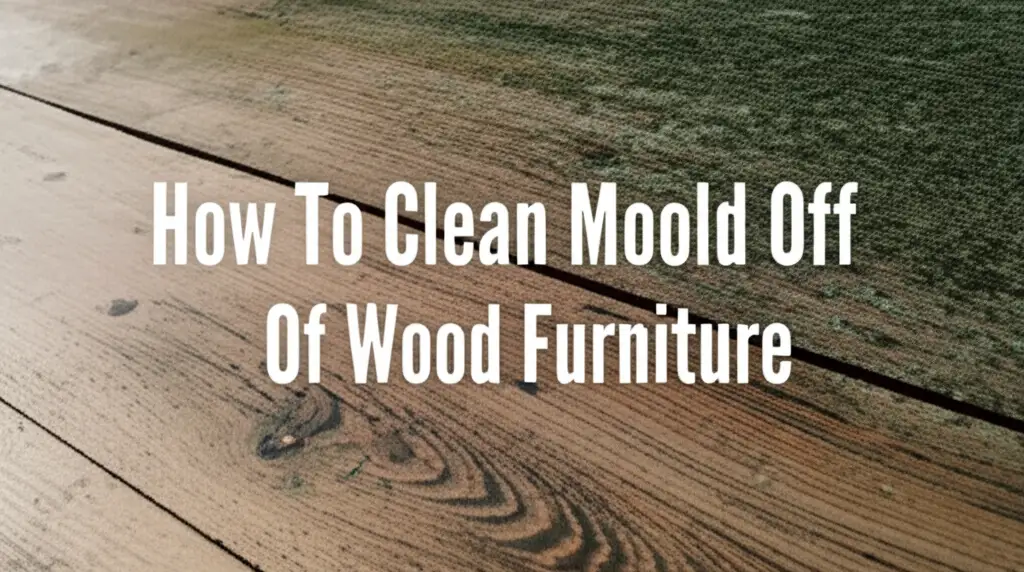· Laundry Tips · 19 min read
How To Clean Mildew From Clothes

Effectively Clean Mildew From Clothes: Your Complete Guide
Have you ever opened your laundry hamper to find a musty, damp smell? Perhaps you saw telltale signs of mildew on your favorite shirt or a forgotten towel. Mildew on clothes is a common problem, especially in humid environments or when items are left damp for too long. It shows up as fuzzy spots, often white, grey, or black.
This guide helps you understand how to clean mildew from clothes. We will cover safe preparation steps, effective home remedies, and tips for stubborn cases. We also share advice on washing, drying, and preventing mildew in the future. My goal is to give you clear, easy steps to get your clothes fresh and clean again.
Takeaway
- Act Fast: Clean mildew as soon as you see or smell it.
- Protect Yourself: Wear gloves and work in a ventilated area.
- Use Household Items: Vinegar, baking soda, and oxygen bleach are effective.
- Dry Completely: Ensure clothes are fully dry after washing to stop regrowth.
- Prevent Future Mildew: Store clothes properly and control humidity.
Clear, Concise Answer to the Main Query
To clean mildew from clothes, first brush off loose spores outdoors. Then, pre-treat affected areas with a solution like white vinegar, baking soda paste, or oxygen bleach. Wash clothes in hot water if fabric allows, adding a cleaning agent. Finally, dry items completely in sunlight or a dryer.
Understanding Mildew on Clothes
Mildew is a type of fungus that grows in damp, warm conditions. It is a common household problem. Clothes provide an ideal breeding ground when they stay wet or are stored in humid places. You might notice a musty smell first. Then, you see small, fuzzy spots on the fabric. These spots can be white, grey, yellow, or even black.
Mildew is different from mold, though people often confuse them. Mildew usually stays on the surface, while mold can root deeper into fabric fibers. However, the cleaning methods for both are very similar. Ignoring mildew can lead to fabric damage and a persistent odor. It can also cause health problems for some people. Prompt action is best to save your clothes and maintain a healthy home environment.
Why Mildew Grows on Clothes
Mildew needs three things to grow: moisture, warmth, and organic material. Clothes give it all three. Leaving wet towels in a hamper, storing damp clothes in a closet, or living in a humid climate all encourage mildew. Sweat, food spills, and even dust on fabric provide the organic material it feeds on. Poor air circulation in closets or drawers also helps mildew spread.
Understanding these conditions helps you prevent mildew. You can take steps to remove its food source or control the environment. Regularly airing out clothes and keeping storage areas dry are key. This knowledge forms the basis for effective cleaning and prevention strategies.
Identifying Mildew vs. Other Stains
It is important to know if you are dealing with mildew. Mildew often has a distinct musty or earthy smell. The spots might look powdery or fuzzy. They usually appear in patches rather than distinct shapes. Common colors are white, gray, light yellow, or black. Other stains, like grease or dirt, usually do not have a strong smell unless old. They also have different textures and colors.
If you suspect mildew, check the back of the fabric too. If the spot has bled through, it is likely mildew. Knowing what you are dealing with ensures you use the right cleaning method. This saves time and protects your clothes from damage.
Essential Preparations Before Cleaning Mildew
Cleaning mildew from clothes requires some preparation. This keeps you safe and helps the cleaning process work better. Start by moving the affected clothes to an outdoor area if possible. This prevents mildew spores from spreading inside your home. Mildew spores are tiny and can easily become airborne. Inhaling them can cause respiratory irritation for some people.
Always wear protective gear. A pair of rubber gloves protects your hands from cleaning solutions. If you are sensitive to spores or have allergies, consider wearing a face mask. Good ventilation is crucial. Open windows and doors, or use a fan if working indoors. Preparing correctly makes the job easier and safer.
Isolating Affected Items
Handle mildewed clothes separately from clean laundry. Do not shake the items indoors. This releases spores into the air, which can land on other surfaces or clothes. Place the mildewed items directly into a plastic bag or laundry basket that you can easily clean later. Keep them away from other fabrics until they are ready for treatment.
Pre-soaking or pre-treating is an important first step for many mildew stains. This helps to loosen the mildew and make it easier to remove during washing. We will discuss specific pre-treatment methods in the next section. Separating items and starting with pre-treatment increases your chances of fully removing the mildew. This also prevents cross-contamination of other clothes.
Protecting Yourself and Your Home
Your health is important when dealing with mildew. Beyond gloves and masks, ensure your workspace is well-lit. This helps you see all mildew spots. If cleaning a large amount, take breaks. You do not want to expose yourself to spores for too long. After handling mildewed items, wash your hands thoroughly. Clean any surfaces the mildewed clothes touched with a disinfectant.
Consider the fabric type of your clothes. Some fabrics, like silk or wool, need gentle care. Harsh chemicals can damage them. Always test any cleaning solution on a small, hidden area of the fabric first. This helps avoid discoloration or damage. These safety and fabric care steps prepare you for effective mildew removal.
Effective Home Remedies to Clean Mildew from Clothes
Many common household items effectively combat mildew on clothes. These remedies are often safer for your fabrics than harsh chemicals. They are also readily available. Always test these solutions on an inconspicuous part of the garment first. This ensures they do not damage or discolor the fabric.
White vinegar, baking soda, and borax are popular choices. Each offers unique properties to kill mildew and remove stains. Using these methods can help you restore freshness to your clothes without strong odors. They also help keep your cleaning routine more natural. This section explores these specific remedies.
White Vinegar Solution
White vinegar is an excellent natural mildew killer. Its acetic acid breaks down mildew. It also helps remove musty odors. You can use it in a few ways. For mild mildew, soak the affected clothing in a solution of equal parts white vinegar and water. Let it sit for 30 minutes to an hour. For tougher stains, apply undiluted white vinegar directly to the mildew spots. Let it soak for 10-15 minutes.
After soaking, scrub the mildew area gently with a soft brush or an old toothbrush. Then, wash the clothes as usual in your washing machine, adding one cup of white vinegar to the wash cycle. This method is safe for most fabrics. It is also effective against both mildew and the accompanying smell. For more details on using vinegar for mold, see our guide on how to clean mold with vinegar. This natural approach often works wonders on fabric stains.
Baking Soda Paste
Baking soda is another versatile cleaning agent. It is a natural deodorizer and has mild abrasive qualities. This makes it good for scrubbing away mildew stains. To use baking soda, mix it with a small amount of water to form a thick paste. Apply this paste directly onto the mildewed areas of the clothing. Make sure the entire affected area is covered.
Let the baking soda paste dry on the fabric for several hours or overnight. Once dry, brush off the excess paste. The baking soda will have absorbed moisture and lifted some of the mildew. Then, wash the garment in your washing machine. You can also add half a cup of baking soda to the wash cycle for extra cleaning power and odor removal. This method is gentle on fabrics while being tough on mildew.
Borax Treatment
Borax is a natural mineral with powerful cleaning and deodorizing properties. It is also effective at killing mildew. To use borax, dissolve half a cup of borax powder in hot water. Add this solution to your washing machine. You can also create a borax paste for pre-treatment. Mix borax with a little water until it forms a thick consistency. Apply this paste directly to the mildew spots.
Let the paste sit on the fabric for at least 30 minutes before washing. For heavily mildewed items, you might want to pre-soak them in a borax solution overnight. Add one cup of borax to a bucket of water and submerge the clothes. After pre-treatment, wash the clothes as usual with detergent. Always rinse thoroughly to remove all borax residue. Borax is strong, so use it carefully and wear gloves.
Tackling Stubborn Mildew Stains and Smells
Sometimes, mildew stains are deeply set or the musty smell lingers. This happens if the clothes sat for a long time with mildew. In these cases, you might need stronger treatments than simple home remedies. Oxygen bleach and commercial mildew removers are good options. These products are designed to break down tough stains and eliminate odors. Always read product labels carefully.
Ensure you use these stronger cleaners in a well-ventilated area. Test them on a hidden part of the garment first. This prevents accidental damage or discoloration. Persistent mildew can be frustrating, but these methods offer a stronger solution. My experience shows that combining methods often works best for very stubborn issues.
Oxygen Bleach for Colorfast Fabrics
Oxygen bleach, also known as color-safe bleach, is a powerful stain remover. It uses oxygen to break down stains and kill mildew. Unlike chlorine bleach, it is safe for most colored and delicate fabrics. It does not strip color. To use oxygen bleach, dissolve a scoop (or as directed on the package) in a bucket of warm water. Submerge the mildewed clothes completely in the solution.
Let the clothes soak for at least four hours, or even overnight, for very stubborn stains. After soaking, drain the water. Then, wash the clothes in your washing machine with your regular detergent. For an extra boost, you can add another scoop of oxygen bleach directly to the wash cycle. This method is very effective at lifting tough stains and deodorizing fabrics. It is a good choice if you are also cleaning clothes that might have been exposed to mold spores, as discussed in how to clean clothes exposed to mold spores.
Chlorine Bleach for White Clothes (Use with Caution)
Chlorine bleach is a very strong disinfectant and whitener. It is highly effective at killing mildew and removing stains from white clothes. However, it can damage or discolor colored fabrics. You must use chlorine bleach with extreme caution. It can also weaken fabric fibers over time. Never mix chlorine bleach with vinegar or ammonia, as this creates dangerous fumes.
For white, bleach-safe clothes, dilute half a cup of chlorine bleach in a gallon of water. Soak the mildewed areas for no more than 30 minutes. After soaking, immediately wash the clothes in the hottest water safe for the fabric. Ensure a thorough rinse cycle to remove all bleach residue. Chlorine bleach should be a last resort for white fabrics only. Its harshness demands careful application.
Commercial Mildew Removers
If natural remedies and bleach are not working, specialized commercial mildew removers exist. These products are formulated to tackle tough mildew and mold stains. They often contain enzymes or strong chemicals designed to break down fungal growth. Always follow the manufacturer’s instructions carefully. These products can be very strong.
Look for products specifically labeled for fabric or laundry use. Some are sprays for pre-treatment, while others are liquid additives for the wash. Wear gloves and work in a very well-ventilated area when using these. Test them on an inconspicuous spot of the garment first. Commercial removers offer a powerful solution when other methods fail.
Washing and Drying Mildew-Affected Clothes
After pre-treating mildew-affected clothes, proper washing and drying are critical. These steps ensure all traces of mildew are gone. They also prevent its return. Do not skip these steps, even if the stain looks gone. The goal is to kill any remaining spores and remove the musty smell completely. This section outlines the best practices for washing and drying.
Using the right water temperature and ensuring thorough drying are key. My personal experience shows that sunlight is a fantastic natural mildew killer. It also helps remove any lingering odors. Pay close attention to these final steps for successful mildew removal.
Washing Machine Cycle
Wash the mildewed clothes separately from other laundry. Use the hottest water temperature safe for the fabric type. Hot water helps kill mildew spores more effectively. Add your regular laundry detergent. You can also add an extra boost to the wash cycle. Consider adding one cup of white vinegar or half a cup of borax to the detergent dispenser. This boosts cleaning and odor removal.
For heavily soiled items, you might need to run two wash cycles. The first cycle helps remove most of the mildew. The second ensures thorough cleaning and rinsing. Always check the garment care label before using hot water. Some delicate fabrics require cold or warm water. If handwashing, consider options like how to wash clothes without a washer or how to wash clothes in a bathtub for guidance.
Drying Mildewed Clothes Completely
Drying is perhaps the most important step in preventing mildew re-growth. Mildew thrives in damp environments. Your clothes must be completely dry before storing them. If possible, hang the clothes outdoors in direct sunlight. Sunlight is a natural disinfectant. Its UV rays kill remaining mildew spores and help bleach out any lingering stains. The fresh air also helps remove the musty smell.
If outdoor drying is not an option, use a clothes dryer. Dry the items on the highest heat setting that is safe for the fabric. Use dryer sheets if you want. Run the dryer until the clothes are bone dry. Do not leave damp clothes in the dryer. This can create a new breeding ground for mildew. Check every item to ensure no damp spots remain before folding and putting them away.
Preventing Mildew Growth on Clothes
Preventing mildew is easier than cleaning it. Mildew needs moisture and warmth to grow. Controlling these factors is key to keeping your clothes fresh and mildew-free. Good habits in laundry care and storage go a long way. This section focuses on practical steps you can take daily. These tips help you avoid the hassle of mildew stains in the first place.
I always tell people that prevention is the best medicine. A little effort now saves a lot of cleaning work later. Keeping your home environment dry and airy makes a big difference. These simple changes can protect your entire wardrobe.
Proper Storage and Air Circulation
How you store your clothes greatly affects mildew growth. Never put damp or even slightly moist clothes in a closet or drawer. Always ensure garments are completely dry before folding or hanging them. Overcrowding closets reduces air circulation. This creates a humid microclimate where mildew can thrive. Leave some space between items.
Use breathable garment bags for clothes you store long-term. Avoid plastic bags, which trap moisture. Consider using cedar blocks or desiccant packets in closets. These help absorb excess moisture and deter pests. Regular airing out of closets by opening the doors helps too. Good air flow is a simple but effective barrier against mildew.
Controlling Indoor Humidity
Humidity is mildew’s best friend. High indoor humidity levels create an ideal environment for mildew to grow on clothes and other surfaces. Aim for indoor humidity levels between 30% and 50%. You can monitor this with a hygrometer. If your home is consistently humid, consider using a dehumidifier. Place it in areas prone to dampness, like basements or laundry rooms.
Ensure proper ventilation in bathrooms and kitchens. Use exhaust fans during and after showering or cooking. Repair any leaks promptly, as standing water is a major source of humidity. Keeping your home dry overall helps prevent mildew on clothes and throughout your living space.
Prompt Laundry Habits
Develop good laundry habits. Do not leave wet clothes in the washing machine or hamper for extended periods. As soon as a wash cycle finishes, transfer clothes to the dryer or hang them to dry. If you cannot dry them immediately, remove them from the washer and hang them to air out until you can dry them properly.
For clothes that get sweaty or damp from use, like gym clothes or swimsuits, wash them as soon as possible. If you cannot wash them right away, hang them up to air dry. Do not toss them into a laundry basket while still damp. This gives mildew a head start. Regular and prompt laundry care is a simple way to keep mildew out of your wardrobe.
Special Considerations for Delicate Fabrics
Delicate fabrics require gentle care when cleaning mildew. Materials like silk, wool, rayon, and lace can be easily damaged by harsh chemicals or vigorous scrubbing. While effective, methods like chlorine bleach are too strong for these items. Even hot water can cause shrinkage or damage. It is important to proceed with caution to save your cherished garments.
Always check the care label on the garment first. It provides specific washing instructions. When in doubt, choose the mildest cleaning method. This section covers tailored advice for treating mildew on delicate fabrics. My focus here is on preserving the integrity and beauty of these special items.
Gentle Cleaning Solutions
For delicate fabrics, stick to very gentle cleaning solutions. White vinegar is often a safe bet. Dilute it further than you would for sturdy fabrics. Mix one part white vinegar with three or four parts water. Lightly dab this solution onto the mildew spots with a clean cloth. Do not rub harshly. Allow it to sit for about 10-15 minutes.
Another option is to use a mild laundry detergent specifically designed for delicates. Create a weak solution with water. Gently sponge the mildewed area. A paste made from baking soda and water can also work. Apply it gently and let it dry. Then, softly brush it off. The key is gentle application and avoiding strong acids or alkalis.
Hand Washing and Air Drying
Delicate fabrics often do best with hand washing after pre-treatment. Fill a basin with cool or lukewarm water. Add a small amount of mild, pH-neutral laundry detergent. Swirl the garment gently in the water. Do not twist or wring the fabric. Rinse thoroughly under cool running water until all soap is gone.
To dry, gently press out excess water by rolling the garment in a clean towel. Then, lay the item flat on a clean, dry towel or hang it on a padded hanger. Avoid direct sunlight, as it can fade some delicate colors. Allow it to air dry completely in a well-ventilated area. This slow, gentle drying process protects the fabric’s structure.
Professional Cleaning for Valuables
If you have valuable or extremely delicate items, consider professional cleaning. Dry cleaners have specialized equipment and knowledge. They can assess the fabric and choose the safest method for mildew removal. This reduces the risk of damage. It is a good option for antique textiles or items with sentimental value.
Inform the dry cleaner that the item has mildew. This helps them take appropriate precautions. While more expensive, professional cleaning is often worth it for irreplaceable items. It ensures the best possible outcome without risking damage at home.
Frequently Asked Questions
Q1: Can I put mildew clothes in the washing machine with other clothes?
A1: It is best to wash mildewed clothes separately. Mildew spores can spread to other garments in the wash. Washing them alone helps prevent cross-contamination. After washing the mildewed items, clean your washing machine by running an empty hot cycle with vinegar or bleach to ensure it is clean for subsequent loads.
Q2: What if the mildew smell remains after washing?
A2: If the mildew smell persists, re-wash the clothes. Add one cup of white vinegar or half a cup of baking soda to the wash cycle. Sunlight is also excellent for odor removal. Hang the clothes outdoors in direct sunlight for several hours after washing. Ensure clothes are completely dry, as residual moisture fuels the smell.
Q3: Is mildew on clothes dangerous?
A3: For most people, direct contact with mildew on clothes is not immediately dangerous. However, breathing in mildew spores can cause allergic reactions, asthma attacks, or respiratory irritation, especially for sensitive individuals. It is best to clean mildew promptly and work in a well-ventilated area to minimize exposure.
Q4: Can I use a regular dryer to remove mildew?
A4: A regular dryer on a high heat setting can help kill remaining mildew spores and dry the clothes thoroughly. However, it will not remove the stain or odor entirely without pre-treatment and washing. Always ensure clothes are completely dry to prevent re-growth, as even slight dampness encourages mildew.
Q5: How do I remove black mildew stains from clothes?
A5: Black mildew stains can be very stubborn. Pre-treat them with undiluted white vinegar or a paste of baking soda. For colorfast white fabrics, a diluted chlorine bleach soak can be effective. For colored fabrics, oxygen bleach is a safer alternative. Scrub gently, then wash in the hottest water safe for the fabric.
Q6: Can mildew stains be permanently removed?
A6: Yes, most mildew stains can be permanently removed with prompt and correct treatment. The key is to kill the fungal growth, remove the stain, and eliminate the odor. Very old or severe mildew that has deeply embedded into fibers might leave a faint shadow, but typically, full removal is achievable.
Conclusion
Cleaning mildew from clothes can seem daunting, but it is a manageable task. You now have several effective methods at your disposal. From common household items like white vinegar and baking soda to stronger treatments like oxygen bleach, you have options. Remember, the key is to act quickly. Do not let mildew sit on your clothes for long. This makes it harder to remove.
Always prioritize safety. Wear gloves and work in a well-ventilated space. After cleaning, ensure your clothes dry completely. This stops mildew from coming back. Preventing mildew is the ultimate goal. Store clothes properly. Control humidity in your home. Adopt good laundry habits. By following these steps, you keep your clothes fresh, clean, and free from mildew. Take action today and reclaim your wardrobe!
- mildew removal
- laundry stains
- fabric care
- musty clothes
- cleaning tips




